Companies that have successfully integrated AI into their operations are reaping substantial rewards. From automating routine tasks to delivering faster, more accurate predictions and uncovering patterns in massive datasets, the scope of AI’s impact continues to grow. New opportunities for AI to provide actionable insights or handle time-consuming work are emerging every day.
But before reaching this point, many organizations had to overcome serious hurdles, like talent shortages and the complexity of managing data. If you’re still navigating these challenges, this guide is designed to give you practical advice on how to build an AI app that drives real business value.
This guide will help you find answers to the following key questions before starting your AI development journey:
- What can you expect from Artificial Intelligence?
- Which industries tend to benefit the most from AI adoption?
- What does the process of developing AI-powered software entail?
- What are the typical challenges in AI development, and how can you address them?
Additionally, we’ll provide guidance on estimating the costs of your AI project and suggest potential AI applications poised for popularity in the near future.
Let’s begin with some key points.
What is an AI application?
Artificial Intelligence (AI) means the capability of machines to think and learn the way people do.
Therefore, creating an AI application means developing a computer program that can perform tasks normally requiring human intelligence. These tasks include reasoning, learning from experience, understanding human language, recognizing patterns, and making decisions.
To develop AI software, developers employ various technologies:
- Machine Learning (ML) allows algorithms to learn from data and make predictions or decisions without being pre-programmed for specific tasks.
- Deep learning uses neural networks—computer systems that imitate layers of neurons in the human brain—to learn from large amounts of data that isn’t organized in a predefined way, such as images and speech.
- Expert systems mimic a human expert’s decision-making in a particular domain by logically processing programmed knowledge.
- Robotics merges AI with physical machines, creating software that controls robots to perform tasks autonomously or semi-autonomously.
- Natural Language Processing (NLP) helps machines understand and generate human language, enabling user interaction with computers by speaking or writing naturally.
- Genetic algorithms mimic natural evolution, generating solutions for complex problems like scheduling or game strategies. They allow software to evolve through iterative improvement based on user input and the ‘fitness’ of the outcome.
AI app vs. traditional app
Let’s summarize the key differences between an app’s functionality that uses traditional rule-based logic and an AI-powered one:
| Feature | Traditional app | AI app |
|---|---|---|
| Core logic | Follows predefined rules and workflows | Learns from data, adapts to new patterns |
| User interaction | Limited to scripted responses or fixed options | Mimics human reasoning with natural, context-aware replies |
| Personalization | Basic, rule-based (e.g., “if user clicked X, show Y”) | Dynamic, based on behavior, preferences, and history |
| Decision-making | Deterministic: same input always yields the same output | Probabilistic: evaluates context and makes nuanced choices |
| Adaptability | Requires manual updates by developers | Continuously improves through training and feedback |
| Scalability of features | Expands only when developers add new features/rules | Expands organically as the model learns from more data |
To illustrate the difference, let’s compare a scripted chatbot with an AI-powered chatbot.
A scripted chatbot follows predefined rules. It typically suggests a list of options for the user to choose from or expects very specific phrasing to trigger a response. If the user input falls outside of its scripts, the bot often replies with something like: “I didn’t understand your question, please try again.” Expanding the chatbot’s capabilities requires manual updates to its knowledge base, where developers add new question-and-answer pairs or rules.
An AI-powered chatbot, by contrast, goes beyond scripts. It can interpret user intent, even when phrased in different ways, and generate responses dynamically. Instead of needing a developer to hard-code every possible question, an AI bot can draw from a broader dataset or knowledge base, scanning it for relevant information and formulating answers on the fly. This allows it to adapt to new information and handle conversations more naturally, mimicking human reasoning rather than simply following a script.
Syndicode’s expertise in AI app development
If you wonder how to build an AI application, Syndicode is an excellent choice for finding specialists to manage your project from start to finish, including post-launch support. We can also provide expert assistance to enhance your core team’s skills with the necessary knowledge.
As an end-to-end custom software development company, we have all the specialists your project might need. Our experts are senior-level professionals in their fields, constantly updating their skills with the latest technologies and best practices.
We’ve delivered various innovative solutions, including a loan origination system with an AI-powered report generation tool, an all-in-one wholesale solution for iPad with image recognition, and a leading job search and HR platform with an ML-powered recommendation system, which we have modernized and continue to maintain.
These are just some examples showcasing our capabilities. If you have a specific project in mind and want to learn more about how we can assist, we invite you to schedule a quick call with us.
Looking for AI experts?
Our team includes experts in every facet of AI and ML development your project might need, from algorithms and model integration to computer vision and NLP. For more information, visit our service page.
See servicesBusiness benefits of AI application development
AI-powered software is definitely an investment, but it pays off quickly. According to Constant Contact, the majority of businesses that have adopted AI and automation saw significant cost reductions and efficiency improvements. And the more they use the technology, the greater the benefits.
Here are some key findings from their report:
- 60% of businesses using AI or automation in their marketing report time savings and increased efficiency;
- 70% of businesses are willing to pay more for a solution that includes AI or automation tools;
- 33% of businesses have saved over 40 minutes per week on tasks thanks to AI or automation.
Now, if you are wondering about reasons to invest in AI app creation, you must know the specific benefits AI offers to businesses and how it can achieve these improvements.
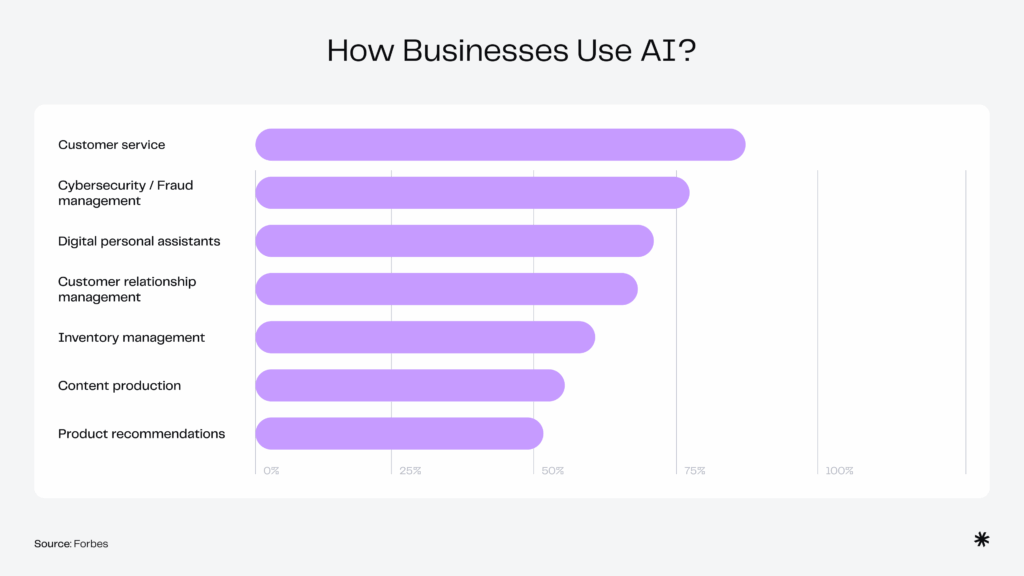
Process automation and efficiency gains
Research shows that AI could add $2.6–$4.4 trillion in value every year, boosting the total impact of AI technologies by 15–40%. And if integrated into everyday software, that impact could nearly double.
These gains come from AI taking over repetitive, time-consuming tasks, such as data entry, scheduling, or customer service requests, so employees can focus on higher-value, strategic work.
Beyond automation, AI also excels at data analysis. It can identify inefficiencies and recommend improvements in areas like logistics, supply chain management, and energy use, helping businesses cut costs and boost operational performance.
Revenue growth
AI has the power to unlock a meaningful revenue boost, adding 1–5% growth annually once fully scaled. This impact is particularly strong in sectors like banking, retail, and pharma.
The uplift comes from AI’s ability to spot patterns in customer data and predict future behaviors and trends. With these insights, businesses can refine their marketing strategies and shape product development in ways that drive more sales.
On top of that, by understanding customer preferences at a deeper level, AI helps companies uncover opportunities for cross-selling and up-selling, ultimately raising the average value of each sale.
Improved user experiences
Automating customer operations can deliver major efficiency gains, potentially increasing productivity by 30 to 45% of current function costs.
Generative AI development takes this even further by transforming personalization and customer interaction. By analyzing user behaviors, preferences, and past interactions, it can generate tailored recommendations and content that truly resonate with customers.
At the same time, AI-powered chatbots and virtual assistants enable 24/7 support, providing instant answers and resolving issues quickly. Together, these capabilities not only improve customer service but also drive stronger user engagement and higher satisfaction.
Competitive advantage
AI can analyze market data and consumer trends more efficiently than traditional methods, providing business owners with valuable insights that can inform strategic decisions. Additionally, it can help innovate by generating ideas and suggesting improvements to products and services.
Improved security and quality control
AI algorithms can monitor and analyze data from various sources in real time to detect fraudulent activities, potential security breaches, and cyber threats, significantly enhancing security measures.
In manufacturing and production, AI systems can inspect and identify defects or quality issues more accurately and consistently than human inspectors, ensuring higher-quality products.
Industries that benefit the most from AI development
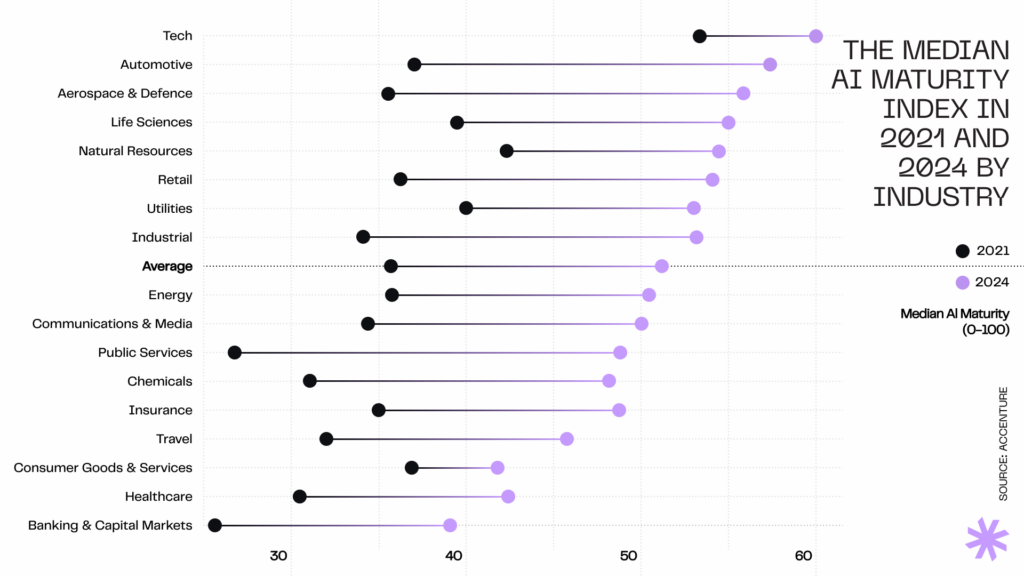
AI development is increasingly capturing attention and investment each year, thanks to its broad and impactful applications. Yet, many companies are still exploring how to create an AI-powered app for outstanding growth and performance.
Here are the leading industries making significant strides in AI adoption:
IT
IT companies employ AI to automate routine tasks, strengthen cybersecurity, and accelerate innovation in software development. Google is a clear example, using AI across multiple areas—from predictive typing in Gmail to AI-driven search algorithms, and even through DeepMind’s research to improve data center efficiency. The latter has been particularly impactful, enabling Google to cut cooling costs by 40%.
Retail
AI enables retailers to elevate the shopping experience with personalized recommendations, smarter inventory management, and faster checkout. Amazon is a prime example: it uses AI to power customized product suggestions, optimize logistics, and run its checkout-free Amazon Go stores.
AI is a key part of Amazon’s broader strategy, which has helped drive a 35% increase in quarterly profit.
Finance
In finance, AI improves risk assessment and fraud detection and personalizes customer service through chatbots and robo-advisors. PayPal is a strong example: by applying advanced machine learning models to analyze transactions in real time, the company improved fraud detection accuracy by around 10% while reducing the computing resources required by nearly eightfold.
Healthcare
AI assists healthcare providers in improving diagnostic accuracy, personalizing treatment plans, and simplifying administrative tasks. Johnson & Johnson’s Polyphonic video-analysis ecosystem, for example, has helped cut surgical training time by about 50%, among other successful AI-led initiatives.
Education
The education sector benefits from AI in personalizing learning experiences, automating administrative tasks, and supporting adaptive learning platforms. Duolingo is a standout example: it uses AI to create personalized language-learning paths that adjust to each user’s progress, strengths, and weaknesses. The company has also credited AI-driven features with fueling strong user growth—so much so that its stock jumped nearly 14%.
Manufacturing
Manufacturing companies use AI for predictive maintenance, production planning optimization, and quality control. Siemens, for example, applies AI-powered software and digital twins to anticipate equipment failures before they happen, helping reduce downtime and cut maintenance costs by up to 40%.
Logistics
AI optimizes routing, supply chain management, and delivery efficiency in shipping and supply chains. UPS’s ORION system is a standout case: it uses advanced algorithms to determine the most efficient delivery routes, saving the company millions of miles and more than 10 million gallons of fuel every year.
Marketing
Marketers leverage AI for improved customer segmentation, campaign personalization, and customer behavior prediction. Netflix is a frontrunner in this space, personalizing viewer experiences through recommendations tailored to individual viewing history and preferences. The company credits its AI-driven personalization with helping maintain one of the lowest churn rates in the industry—about 3.5%, compared to an industry average of 5.5% across streaming platforms.
Travel
The travel industry is embracing AI technology to boost personalization and profitability, applying it in areas such as dynamic pricing, tailored recommendations, chatbots, fraud detection, and demand forecasting.
Expedia, for example, developed an AI-driven recommendation engine that analyzes past bookings, user behavior, reviews, and preferences to suggest hotels, flights, and packages customers are most likely to book. More recently, it integrated conversational AI, enabling travelers to plan trips in everyday language—like asking, “Find me a beachfront hotel in Spain for under $200 per night in October.” As a result, the company boasts a 2x increase in customer satisfaction and a significant boost in revenue.
Turn ideas into market-leading innovations
Let our AI development team guide you in creating a smarter, future-ready business by strategically deploying cutting-edge software. Simply share your needs with us by completing a brief questionnaire.
Contact usHow to create an AI app: the actual steps
Different companies may have varying approaches regarding how to build AI software, depending on their resources and available skills. Here’s a general workflow as practiced at Syndicode:
1. Define the problem
The first step in any AI initiative is to clearly define the business problem or opportunity. AI is not about “adding technology for the sake of it,” it’s about enabling growth, efficiency, and resilience.
Start by asking:
- What specific challenge are we addressing? (e.g., high churn, rising support costs, inefficient supply chain)
- What measurable improvement do we want to achieve? (e.g., reduce churn by 10%, cut support costs by 30%, shorten production cycles by 15%)
These objectives should be concrete, measurable, and tied to financial or operational outcomes—not abstract technology goals. At Syndicode, we start every AI project by setting SMART goals (Specific, Measurable, Achievable, Relevant, Time-bound)—clear, measurable targets that are realistic, relevant to your business, and tied to a timeline.
To get there, we recommend running a discovery session with all key stakeholders. This structured process helps collect requirements, align expectations, and ensure the AI initiative is rooted in real business needs. It also helps surface risks and dependencies early, avoiding costly surprises later.
Once the objectives are clear, validate whether AI is the right solution. A feasibility study helps confirm if the technology can realistically deliver the desired outcomes. Business analysis services can be invaluable here, ensuring that the project supports long-term strategy rather than becoming a costly side project.
Practical examples of AI aligned to business goals
| Business request | Objective | AI capability | Example outcome |
|---|---|---|---|
| Estimate sales figures for the next quarter | Forecast demand | Forecasting | More accurate revenue planning |
| Identify why customers abandon carts | Reduce churn | Impact analysis | 10% improvement in conversion rate |
| Segment customers into target audiences | Increase marketing ROI | Clustering | Better targeted campaigns |
| Analyze customer feedback sentiment | Improve retention | Classification | Faster response to negative feedback |
| Spot buying patterns or trending topics | Drive upsell/cross-sell | Association | Higher average order value |
| Detect anomalies in transactions | Prevent fraud | Anomaly detection | Reduced financial losses |
2. Assess data readiness
AI is only as strong as the data behind it, making the availability of high-quality, relevant, and well-governed data a crucial condition for ROI. Here’s the general workflow for data preparation for AI development:
- Inventory your data
Review what you already have, checking for volume, quality, and accessibility. This includes internal databases, customer records, transaction logs, sensor data, or public datasets. - Address gaps
If the available data isn’t sufficient, plan to collect, purchase, or responsibly generate the missing pieces. For example, forecasting models may need historical market data, while customer-facing AI may require behavioral or sentiment datasets. - Ensure compliance
Build a governance framework to manage data use responsibly. Compliance with regulations like GDPR or CCPA is not optional: it protects your business and builds trust with customers.
Poor data leads to poor predictions, wasted investment, and lost trust. Recognizing data’s role in the AI development process is critical to building scalable solutions that actually work for the business.
Examples of AI use cases and data needs
| AI application | Best data sources | Business outcome |
|---|---|---|
| Forecasting | Market data, internal sales records | More accurate revenue planning and ROI projections |
| Impact analysis | Customer journey data, product usage reports | Identify why customers churn or what drives conversions |
| Clustering | Customer demographics, purchase history | Smarter segmentation for targeted marketing |
| Classification | Customer feedback, transaction data, support tickets | Detect sentiment, predict purchase likelihood, or automate support responses |
| Association | Retail transaction logs, consumer behavior data | Discover cross-sell and upsell opportunities, spot buying trends |
| Anomaly detection | Transaction logs, sensor, or network data | Detect fraud or equipment failures before they escalate |
3. Decide on approach: custom vs. pre-built solutions
Your project’s size, budget, and strategic goals will determine whether you should invest in a custom AI model or leverage external APIs and cloud services. Each path has clear advantages and trade-offs.
Custom AI application development
- Higher cost and longer timelines, but offers maximum control
- Best when AI is core to your business model or when you need specialized features that competitors can’t easily replicate
- Delivers competitive differentiation, since models are built on your own data and tuned to your unique needs
Pre-built APIs / cloud services
- Faster and cheaper to implement, making it ideal for supportive functions like chatbots, image or speech recognition, and translation
- Minimal setup required: you can integrate services from providers like OpenAI, Google Cloud, or IBM Watson via API
- The trade-off: less tailoring, meaning your solution may look and perform similarly to competitors using the same tools
Choose based on your budget, timeline, and the role AI plays in your business. If it’s a core capability that differentiates you, a custom model is worth the investment. If it’s a supporting functionality, pre-built services deliver quick wins without heavy upfront costs.
4. Assemble the right AI development team
The AI app’s success depends heavily on assembling the right team. A strong AI development team typically includes:
- Product manager, who ensures the project aligns with business goals, sets priorities, and translates technical outputs into measurable ROI
- Data Scientist, who uncovers insights from data, designs experiments, and validates whether the models deliver real value
- ML engineer, who builds, trains, and optimizes the AI models, ensuring they perform reliably in production
- Data engineer, who creates and maintains the infrastructure for collecting, storing, and processing data that AI requires
Together, these roles provide the balance of strategy, analytics, engineering, and infrastructure needed to design and implement the app’s logic. You can hire these specialists to work in-house under your management, or outsource the development process partially or entirely to an AI development company.
In-house vs. outsourcing
The decision often comes down to cost, expertise, and speed. Building an in-house team offers greater control but requires significant investment in salaries, training, and infrastructure. Outsourcing, whether partially or fully, gives you access to specialized expertise and accelerates delivery. This is especially valuable if your company lacks AI talent or needs to move quickly.
Hybrid models
Many businesses adopt a hybrid approach: outsourcing specific roles or phases of the project (e.g., model prototyping or infrastructure setup) while keeping strategic oversight and sensitive data in-house. This balances cost control with access to deep expertise, letting you scale resources up or down as needed.
Hiring model comparison
| Model | Cost | Expertise | Control | Best for |
|---|---|---|---|---|
| In-house | High upfront (salaries, infrastructure, training) | Dependent on your ability to hire and retain talent | Full ownership of strategy, data, and processes | Long-term AI initiatives that are core to your business |
| Outsourced | Flexible, usually lower than building a full team | Immediate access to specialized AI/ML skills | Limited—managed by vendor, with oversight through contracts/SLAs | Companies needing fast results or lacking in-house AI expertise |
| Hybrid | Balanced—core team in-house, specialists outsourced | Access to niche expertise without full-time hires | Strong control over strategy + selective outsourcing for efficiency | Businesses seeking cost savings while retaining oversight and alignment |
Quick guidance:
- If AI is central to your business model, build a core in-house team
- If AI is supportive, outsourcing offers speed and efficiency
- If you need both control and flexibility, a hybrid model is often the smartest choice.
5. Run a pilot / Proof of Concept (PoC)
Instead of trying to overhaul entire workflows at once, focus on one process or dataset where AI can deliver quick, measurable value. This minimizes risk while providing early evidence of what works and what doesn’t.
A PoC is designed to validate feasibility: does the AI model perform as expected with your data? At the same time, it’s your first chance to measure ROI potential: for example, reducing manual effort, cutting costs, or improving accuracy. Involving end users early also helps you gather feedback to ensure the solution solves real problems, not just technical ones.
Finally, the results of a PoC should inform your next steps. Use them to refine the project scope, confirm success metrics, and decide where to scale. That way, when you move to full deployment, your investment is targeted, strategic, and backed by evidence rather than assumptions.
6. Build and train the AI model
When your team trains or fine-tunes a model, there are three priorities to keep in mind:
- Accuracy with perspective: The model must be accurate enough to deliver business impact, whether that’s reducing churn, predicting demand, or automating support. Chasing marginal accuracy gains can drain time and money without improving ROI
- Fairness and explainability: AI must avoid hidden biases that could harm customers or damage trust. And both executives and regulators increasingly expect AI decisions to be explainable, not a “black box”
- Balance between performance and resources: Every extra point of accuracy comes at a cost in data, computing power, and time. Leaders should always ask: Is this model good enough to create value, or are we over-investing in technical perfection?
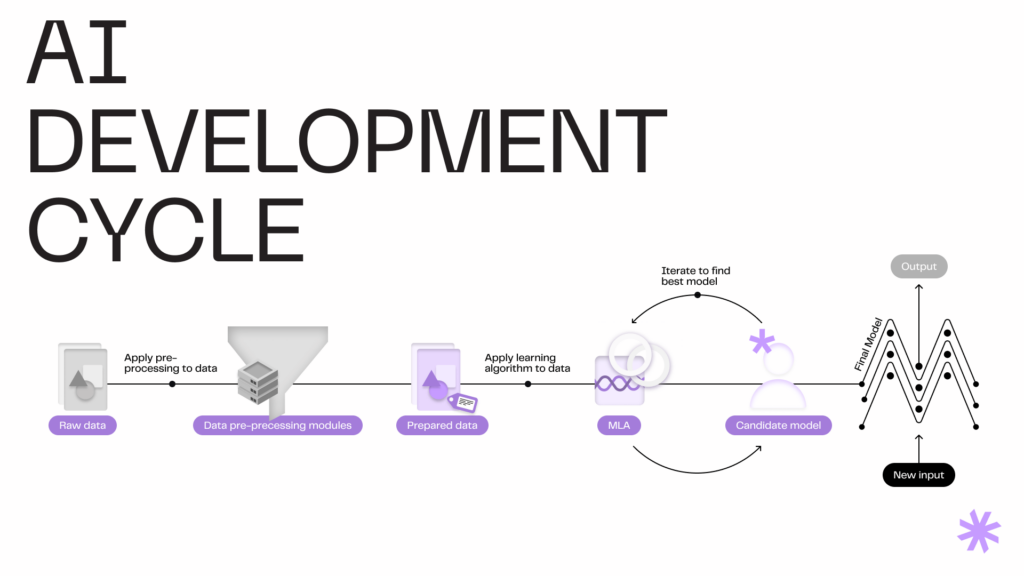
7. Integrate the AI solution into workflows
The real value of an AI model only comes when it’s successfully deployed and adopted across the business. For executives, three priorities stand out:
- Seamless integration with existing systems: Your AI app should connect smoothly with core platforms like CRM, ERP, accounting software, and customer support tools. This ensures data flows without friction, and employees can access AI insights directly within the systems they already use. If the app is customer-facing, seamless distribution through the Apple App Store, Google Play, or other platforms is equally important to ensure accessibility and visibility
- User-centered design for adoption: Even the most powerful AI won’t deliver results if people don’t use it. Interfaces must be intuitive, outputs easy to interpret, and the app designed around how end-users actually work day to day
- Change management for trust and usage: Introducing AI changes how employees work. Plan for communication, training, and support so staff understand the benefits, trust the outputs, and adopt the tool rather than resist it.
Finally, continuous monitoring after deployment is critical. AI models must be regularly checked for accuracy, fairness, and relevance to ensure they continue to meet business objectives as data and conditions evolve.
Remember: deployment isn’t just about getting the technology live; it’s about ensuring the AI solution integrates with your systems, is embraced by your people, and consistently supports business goals.
8. Maintain and evolve the AI model
Once a model proves successful and consistently delivers value, businesses should look to scale AI to additional use cases—applying it across departments, processes, or customer touchpoints. This is where AI evolves from a pilot project into a true growth driver.
At this stage, user feedback becomes crucial for identifying which areas benefit most and for refining the solution to ensure adoption.
At the same time, AI isn’t a “set it and forget it” investment. Companies must stay vigilant about compliance, bias, and transparency. Regulations like GDPR and CCPA continue to evolve, and so should your governance practices.
Another risk factor: AI models may become less effective over time, a so-called model drift. That’s when the model’s accuracy declines as new data or changing market conditions no longer match what the model was trained on. Left unaddressed, drift can quietly erode performance and undermine trust. That’s why it’s critical to monitor outputs regularly, retrain with updated data, and adjust the model as needed to keep it aligned with real-world conditions.
To manage this effectively, many organizations turn to trusted IT maintenance services providers. Being one of them, Syndicode provides flexible support and maintenance to ensure clients’ AI systems remain accurate, compliant, and cost-effective while freeing your team to focus on strategy and growth.
Ready to turn AI into ROI?
Talk to us about the smartest way to apply AI in your business.
Contact usChallenges in AI development
Anyone exploring how to build an AI app has likely run into the unique challenges of this fast-evolving field. Earlier, we discussed the most common risks businesses face with AI and the strategies to address them. Below, we’ll briefly recap the key points.
Data availability and quality
AI depends on large volumes of clean, relevant data, but many companies lack access to datasets that are comprehensive and reliable. Poor data leads to weak models and missed opportunities.
How to tackle it: collaborate within your industry to expand data access, responsibly augment datasets, and invest in rigorous data cleaning.
Bias
AI can unintentionally reinforce bias, creating unfair outcomes that harm reputation and invite legal risk.
How to tackle it: diversify training data, apply bias-detection analytics tools, and involve external experts with different perspectives to spot blind spots early.
Integration and scalability
AI projects often stall when they can’t fit seamlessly into existing workflows or scale as data volumes grow.
How to tackle it: design with modular, flexible architectures, use cloud platforms for scalability, and rely on experienced DevOps teams to streamline deployment.
Regulatory compliance
Shifting regulations around privacy, security, and ethics make compliance a moving target—especially for global businesses.
How to tackle it: prioritize transparency in AI systems, involve legal and compliance teams from the start, and conduct regular audits to stay ahead of regulatory changes.
Talent acquisition and retention
The shortage of AI talent slows adoption and raises costs. At the same time, retaining top performers requires more than just competitive pay.
How to tackle it: build an innovative, learning-oriented culture, offer ongoing training, and consider outsourcing to trusted partners like Syndicode to ensure uninterrupted progress.
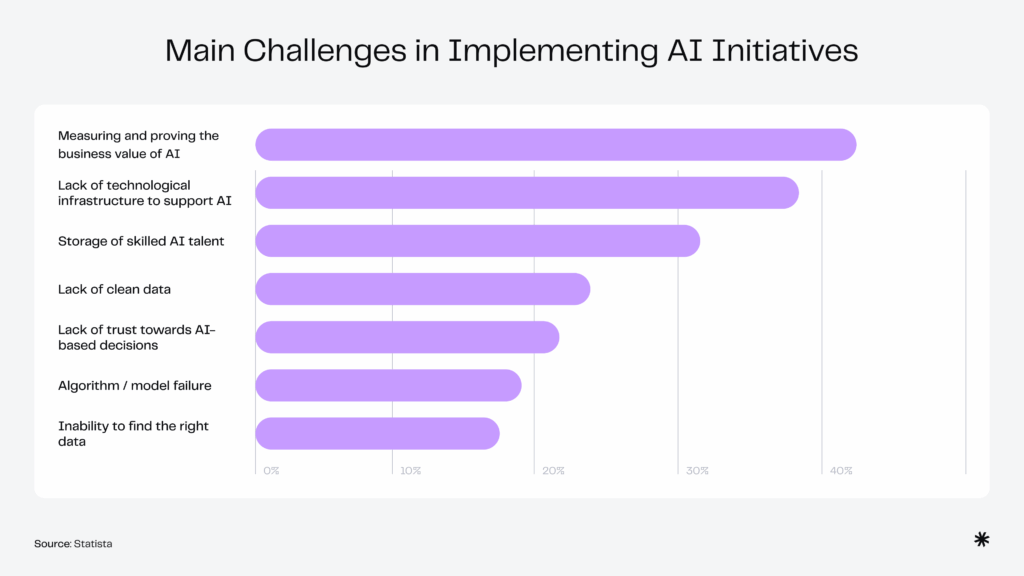
If you’re struggling with these AI challenges—or unsure about the effectiveness of your current strategy—Syndicode is here to help.
Our team combines deep technical expertise with a business-first mindset to tackle the toughest barriers to AI adoption. We design AI systems that integrate seamlessly, comply with evolving regulations, and generate measurable business value.
Beyond the development process, we provide consulting to help clients shape strategies aligned with their goals, infrastructure, and long-term growth. With flexible engagement models and access to top AI talent, Syndicode enables companies to move faster, reduce risk, and make AI work for their needs.
Not sure how AI fits into your business strategy?
Book a consultation to map out a clear strategy tailored to your business.
Let’s talkHow much does it cost to build AI-powered apps?
Building an AI app typically costs between $30,000 and $150,000, depending on complexity, data needs, and infrastructure. Simple apps using pre-trained models can start from a few thousand dollars, while custom enterprise-grade AI solutions may exceed $1 million.
If you want more detail on factors comprising the cost of AI development, go to our guide on estimating the cost of custom software development projects. Here, we’ll give a breakdown of the main cost drivers and what they mean for your budget.
Cost factor 1: Technology & infrastructure
When using cloud APIs, entry-level costs can be as low as fractions of a cent per request (e.g., NLP at ~$0.004/request). This route is fast and inexpensive, lets you start small and scale gradually, but offers less customization.
With custom infrastructure, high-performance GPUs can cost $10K+ each if purchasing or several dollars per hour to rent. This option requires more investment but provides control and differentiation. It makes the most sense when AI is at the core of your business strategy.
Cloud API costs.
| Provider/AI service type | AWS AI | Google Cloud AI | Azure AI |
|---|---|---|---|
| Computer vision | Starting at $0.001/image or $2/hour | Starting at $4.84/hour | Starting at $1/1,000 transactions |
| NLP | Starting at $0.004/request or $0.01/minute | Starting at $8.35/1,000 records | Starting at $1/1,000 records |
| Forecasting | Starting at $0.2/1,000 data points | Starting at $0.08/node hour | Starting at $3.75/30 time series |
Custom infrastructure costs
| Hardware type | Estimated cost |
|---|---|
| GPU | Starting at $10K per unit (Nvidia A100) Starting at $1.14/hr for rental |
| FPGA | $5–$100K, depending on capability |
| ASIC | Starting at $150K |
Cost factor 2: Data preparation
According to Dimensional Research, AI and ML projects typically require about 100,000 data samples to be effective. Depending on the amount of data you have and your needs, building a robust training set can range from $10K to $85K+, factoring in sourcing, cleaning, and annotation.
Cost factor 3: Talent
Annual salaries of AI/ML development teams vary widely by region. For example:
- North America: $40K–$112K per AI/ML engineer
- Eastern Europe or Latin America: $30K–$75K for equivalent roles
Outsourcing can reduce costs by 40–60% while giving access to senior expertise.
Cost factor 4: AI model training
Model training costs scale with complexity and data size. Simple models can cost a few thousand dollars, while training a cutting-edge large model can run into the millions.
Here’s a comparison of various cloud instances for training costs, suggested by an author on Medium. The estimations are based on these parameters:
- Model Hub: Hugging Face
- Model Name: BERT
- Data Size: 5 GB
- Number of Epochs: 100
- Batch Size: 64
| Instance (AWS) | Estimated training time | Estimated cost |
|---|---|---|
| c5.2xlarge.od | 12.88 hours | $4.38 |
| c4.large.od | 46.23 hours | $4.62 |
| c6g.8xlarge.od | 6.19 hours | $6.75 |
| c6g.medium.od | 248.33 hours | $7.48 |
| c6i.large.od | 85.73 hours | $7.72 |
Cost factor 5: Maintenance
Companies typically spend 25–75% of the original build budget on monitoring, retraining, compliance, and support.
AI development cost overview
| Category | Typical range | ROI perspective |
|---|---|---|
| Technology & infrastructure | From <$0.01 per API call to $10K+ per GPU (or $2–$10/hr cloud rental) | Cloud APIs = fast, low cost; Custom infra = higher spend but creates differentiation if AI is core to business |
| Data (Collection & preparation) | $10K–$85K+ depending on volume & complexity | Clean, well-annotated data ensures accuracy and avoids costly rework |
| Talent (In-house vs. outsourcing) | $25K–$50K/yr (outsourced engineer, Eastern Europe/LatAm) to $90K–$112K+ (North America) | Outsourcing can cut costs 40–60% while accessing senior expertise; In-house offers control but higher long-term spend |
| Model training & iteration | Thousands to millions, depending on model complexity & scale | Balance performance with cost: avoid over-investing in marginal accuracy gains |
| Ongoing operations & maintenance | 25–75% of the initial build cost annually | Continuous monitoring, retraining, and compliance keep AI accurate, trusted, and ROI-positive |
How to choose the best AI development company for your project?
Selecting the right AI development partner is one of the most important decisions you’ll make. The right company ensures your investment delivers ROI and positions your business for long-term success. Here’s what to look for:
Domain expertise: Proven experience in your industry is critical. Syndicode has successfully delivered AI projects across e-commerce, education, retail, healthcare, travel, and more. You can explore our featured cases or speak with our sales team for examples relevant to your business;
Technical skills: Look for demonstrated expertise across AI disciplines like machine learning, natural language processing, computer vision, and predictive analytics backed by real case studies. Syndicode’s specialists are vetted experts in all major AI fields, continuously staying on top of industry trends. We carefully choose projects that challenge our team, ensuring their skills remain sharp and ahead of the curve;
Business understanding: AI should be tied to measurable outcomes, not just technical milestones. At Syndicode, discovery sessions are integral to our process, and we also offer business analysis services to ensure every AI initiative is tied to your strategy and long-term value;
Team composition: Successful AI projects require more than coders. Syndicode provides full, independent teams that can handle projects end-to-end, as well as individual specialists to strengthen your in-house team, or dedicated teams that work under your direction;
Flexibility & engagement models: The partner should offer models like dedicated teams or time & material contracts, with the ability to scale resources up or down as needed. Syndicode offers flexible engagement models that adapt to your needs;
Track record & trust: Client references, verified reviews on platforms like Clutch or G2, and success stories show whether the company can deliver. Syndicode holds a 4.8-star rating on Clutch, backed by success stories that highlight our reliability, collaboration, and results;
Post-launch support: AI is not a one-off project. Syndicode provides ongoing monitoring, retraining, maintenance, and compliance updates to keep your AI app accurate, compliant, and effective long after launch.
Trends in AI app development to prepare for in 2026 and beyond
In 2025, the AI market has matured, making competition tougher for newcomers. Yet, AI development has become more accessible, favoring smaller, less resource-intensive models that can be run locally on small devices.
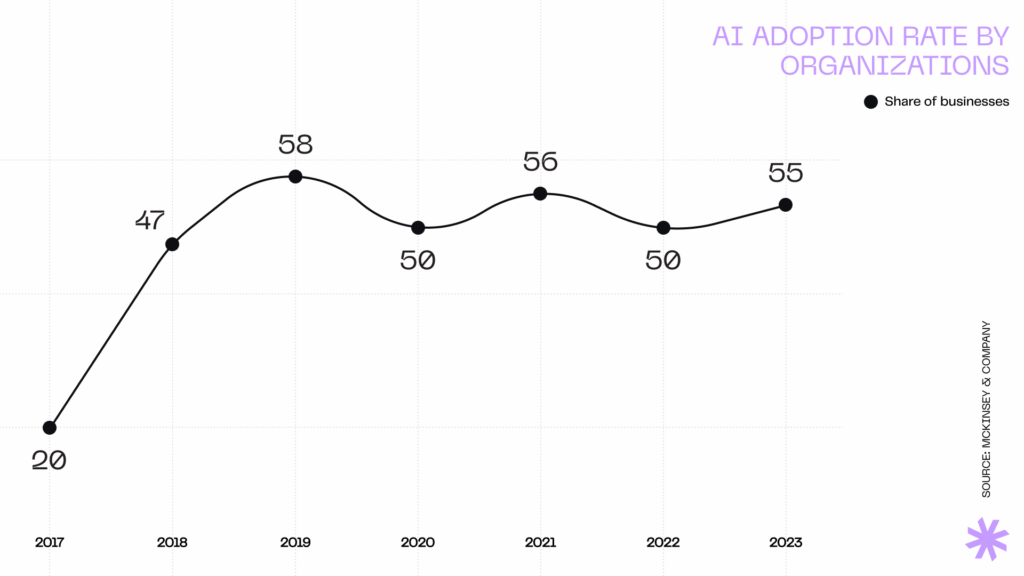
As AI hype settles, companies focus on practical AI uses and integration, giving way to specialized solutions and presenting AI development opportunities in niche markets.
Let’s look at the main trends we see in AI application development:
Low-code/no-code platforms will democratize software development
Low-code/no-code AI is lowering the barrier to entry, enabling business users to build simple software without large engineering teams or even writing code at all. While promising for quick wins, these tools are best seen as complements rather than replacements for full-scale development where complex code might be needed.
We explore in detail the limitations of low-code/no-code development and where these platforms truly shine in our earlier blog post.
Agentic AI and autonomous AI agents will further boost automation
Agentic AI enables automation of multi-step processes that go far beyond today’s chatbots and copilots. Instead of completing single tasks, AI agents can connect different systems and handle workflows, significantly saving time.
Right now, it’s best used in safe pilot projects, like back-office operations or customer support routing. But over the next 1–3 years, it will expand into more important business areas. Companies that start experimenting now will be better prepared to scale when the technology matures.
For most businesses, the smartest approach is to adopt agentic AI through platforms or partnerships, not to build it fully in-house unless AI is central to the business model. This ensures faster ROI, lower risk, and access to proven expertise.
Generative AI will become a standard business layer
Right now, companies are split. Some have gone “all in,” using generative AI to replace human functions in content creation, customer support, and even parts of product development. Others are more cautious, holding back because of concerns over accuracy, compliance, and brand risk.
Over the next few years, we expect the middle ground to become the norm. Generative AI won’t replace human work wholesale. Instead, it will shift into being a strategic tool adopted with oversight—much like cloud computing or CRM systems became standard business layers in past decades. The companies that master the balance between innovation and control will gain the greatest competitive advantage.
Key shifts to expect:
- Governance & trust – Clear rules will be set for when and how to use AI, with monitoring to ensure compliance and protect brand reputation;
- Hybrid workflows – AI will be used for drafts, with humans refining and approving the final version;
- ROI-driven adoption – Executives will greenlight AI only if it shows clear business results: cost savings, faster delivery, or better decisions;
- Specialization – Instead of relying on generic AI tools, companies will increasingly adopt industry-specific AI (finance, healthcare, retail, etc.).
AI will directly affect geopolitics
AI is becoming a lever of global power. Governments are already using AI for economic advantage, controlling access to critical hardware, and even shaping public opinion with synthetic content. Trade restrictions on AI chips and infrastructure are being used strategically to limit rivals’ competitiveness.
For businesses, this means supply chains, market access, and regulatory environments will be directly affected by AI geopolitics. Just as sanctions or tariffs reshaped global trade in the past, AI-related restrictions will influence where companies can source components, how they handle data, and which markets they can enter.
In 2026 and beyond, diversifying supply chains, ensuring compliance with shifting regulations, and scenario-planning for trade disruptions will be critical to staying competitive.
How to build an AI app: final words
Developing AI applications may seem daunting, yet it promises substantial rewards through cost savings and enhanced operational efficiency. The key is to treat AI as a business enabler, not just a technical experiment.
The future belongs to businesses that act now. Let’s explore how AI can reduce costs, accelerate growth, and strengthen your competitive edge.
Frequently asked questions
-
How hard is it to build your own AI app?
AI development, web or mobile, requires a solid background in computer science, mathematics, and knowledge specific to the project’s domain. It also involves a vast amount of high-quality data and might take a long time to train the model, often using significant GPU resources. Yet, it’s not overwhelmingly difficult. You can build and launch a capable model with careful planning, a skilled development team that knows how to create artificial intelligence, and some room for experimentation. Then, as you gather more data, you can refine and expand it to better meet your needs.
-
What is required to create an AI app?
Building a successful AI app requires high-quality data, specialized expertise, robust computing resources, ongoing maintenance, and compliance with ethical and legal standards.
Data is critical for creating an AI model that makes reliable predictions and is aligned with the ROI expectations.
Skilled expertise is equally important—backgrounds in computer science, mathematics, and domain knowledge are often scarce, which is why many companies rely on AI development partners.
Robust computing power is another factor, as training advanced models demands GPUs or scalable cloud services that can be costly but enable flexible experimentation.
Once deployed, models must be monitored and retrained to prevent performance drift, ensuring accuracy over time.
Finally, governance is critical. Ethical risks such as bias and regulatory requirements like GDPR or CCPA must be addressed early to protect reputation and ensure compliance. -
How long does it take to build an AI app?
Most AI apps take 3–12 months to develop, depending on complexity, team expertise, and data availability. Basic AI features (like chatbots or image recognition) can be built in a few weeks, while custom models for advanced natural language processing or computer vision often take a year or more.
Projects involving novel research or highly specialized AI models often take longer, requiring extensive R&D, large datasets, and significant computational resources. -
Is it expensive to develop AI software?
For small projects or applications using pre-trained models, the costs are relatively low, ranging from a few thousand to tens of thousands of dollars. However, for custom AI solutions, especially those requiring extensive data collection and processing, unique model development, and significant computational resources, the costs can quickly escalate to hundreds of thousands or even millions of dollars.


